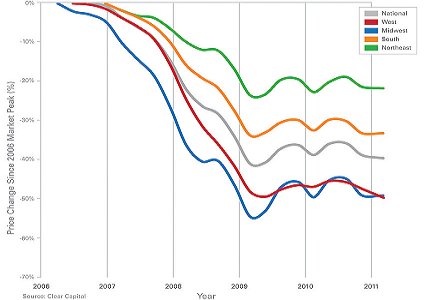April 8, 2011 (Chris Moore)

Clear Capital released its monthly Home Data Index (HDI) Market Report which shows the Western region of the United States leading the nation in price declines (-4.3%), while in the rest of the U.S., prices remain flat. Prices through March in the Western U.S. have reached lows not seen since 2001 with the report calling the declines as having reached “double dip territory.”
The HDI reports that overall, quarter over quarter home prices fell by 1.3 percent.
“The latest data through March supports our view that many markets are continuing to see relief from the significant price declines we observed through January,” said Dr. Alex Villacorta, director of research and analytics at Clear Capital. “While some markets are already in double dip territory, specifically in the West, widespread fear of a collective fall in market prices is overstated.”
Villacorta adds that it is Clear Capitals belief that the disparity in prices between the West and the other regions is based on the amount of REO saturation. Out of all the regions, only the Western region showed gains in its REO saturation over the previous quarter.
Quarter over quarter, prices in the West declined by 4.3 percent. Prices in the Midwest and the South remained unchanged for the quarter, and prices in the Northeast declined by 0.5 percent.
Compared to six months ago, prices in the West have declined 7.3 percent, while prices in the Midwest have fallen 7.8 percent, prices in the South have fallen 4.4 percent, and in the Northeast prices have fallen 3.6 percent.
Year over year, prices in the West have fallen 5.2 percent, increased 0.9 percent in the Midwest, fallen 1.1 percent in the South, and have increased 1.3 percent in the Northeast.
The best performing Metropolitan Statistical Areas (MSAs) were the Bridgeport/Stamford/Norwalk Connecticut area which saw a gain of 9.4 percent for the most recent quarter, followed by the New York/Long Island/No. New Jersey area which increased 4.6 percent for the quarter, and the Dallas/Ft. Worth/Arlington Texas area, which saw price gains of 4.5 percent for the quarter.
Markets in the South and Northeast regions dominated this month’s quarter-over-quarter price gains, taking up 12 of the 15 spots on the list. The only markets outside these regions to make the list were the Ohio markets of Cleveland, Cincinnati, and Columbus.
The lowest performing MSAs were the Detroit/Warren/Livonia Michigan area where prices declined by 18.9 percent for the quarter, followed by the Milwaukee/Waukesha/West Allis Wisconsin area, where prices declined by 13.3 percent, and the Raleigh/Cary North Carolina area, which saw prices decline by 9.8 percent.
Home prices in the West are at their lowest since 2001, becoming the first region to double dip. The price declines reflect the extent of distressed activity in the region as 40.8 percent of all sales are distressed properties.
Almost all areas have seen the price gains they experienced in the first half of 2010 caused by an uptick in housing activity due to the government home buying assistance programs wiped out.
The Clear Capital HDI Market Report has displayed consistent market trends as other leading indices (peak, trough, secondary trough and tax credit run-ups). Despite these consistencies, a critical difference is that HDI’s methodology enables more timely and granular reporting.
Tags: Clear Capital, home data index, HDI, price declines, double dip territory, best performing markets, lowest performing markets
Sources:
Clear Capital




